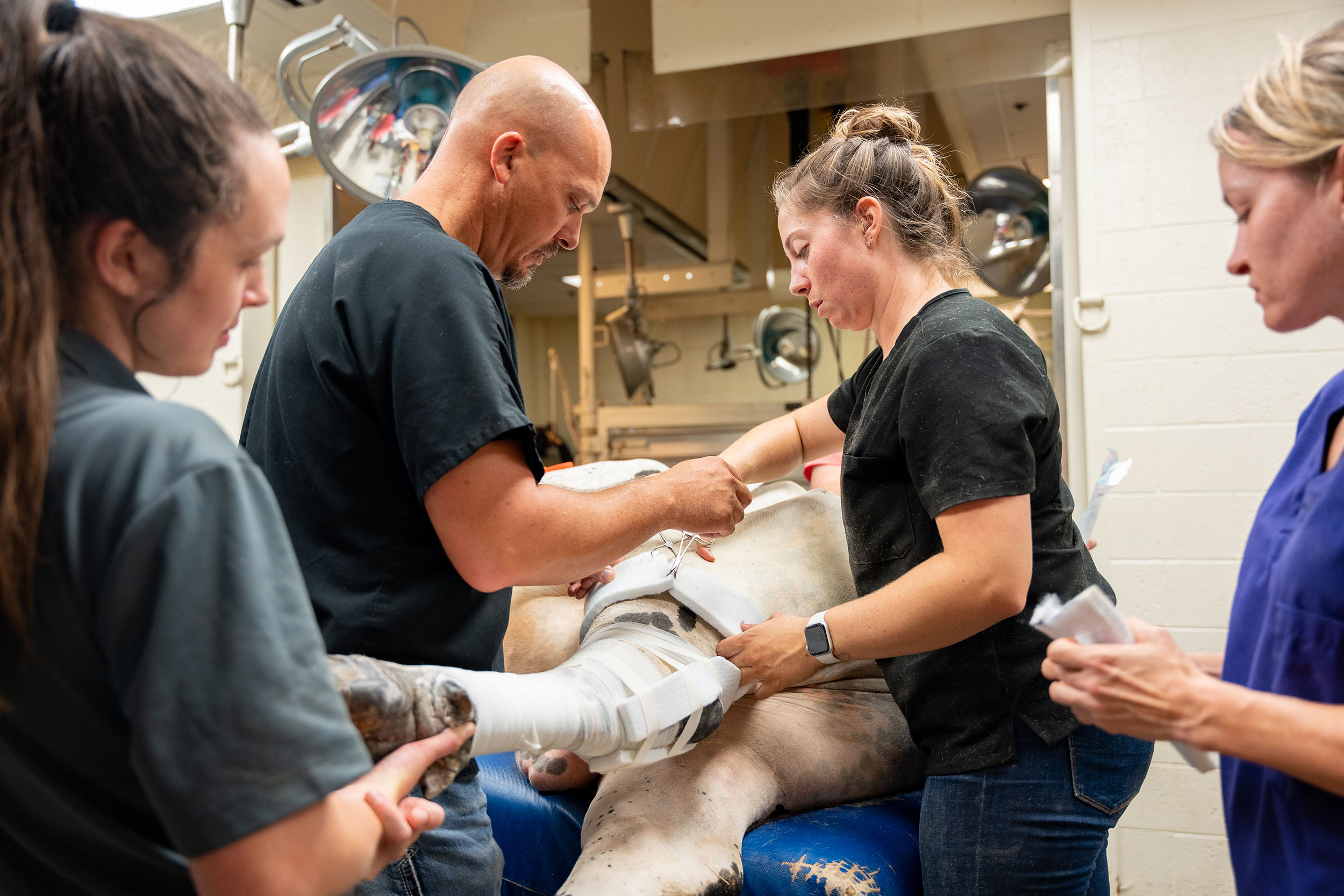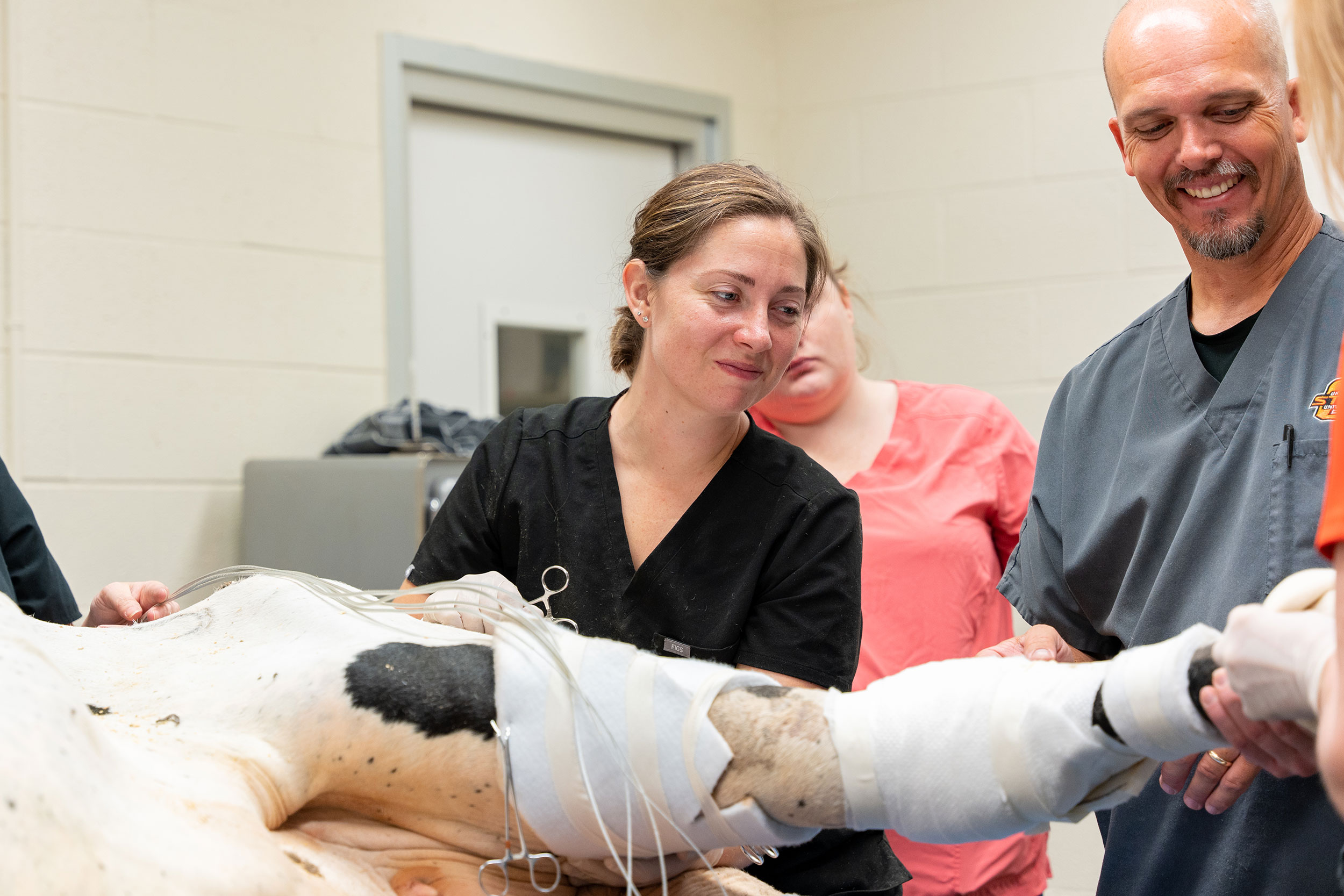
A Labor of Love
Tuesday, February 14, 2023
Media Contact: Kaylie Wehr | Coordinator, Marketing and Public Relations | 405-744-6740 | kaylie.wehr@okstate.edu
What comes to mind when you hear the phrase ‘a girl’s best friend?’ Maybe a loyal canine or sparkling diamonds? Probably not a 1,520-pound bucking bull, but for 13-year-old Addi Drury, she couldn’t think of a better companion.
Addi’s parents, Chad and Jenny Drury, own Nothin’ But Try Ranch in Erick, Oklahoma. Hard Labor was born when Addi was 7 and raised on the ranch as part of the family.
“He is Addi’s best friend,” Chad Drury said. “She raised him on a bottle, that bull means everything to her.”
Hard Labor grew to be an elite athlete, competing in various competitions as a bucking bull. In June 2022, Hard Labor was competing in North Carolina when tragedy struck. During the competition, he stopped putting weight on one of his back legs.
The Drurys knew immediately something was wrong and where exactly they needed to take him. The family loaded up and headed to the Oklahoma State University Veterinary Medical Teaching Hospital.
“We chose OSU because it is the best in the business at handling bucking bulls,” Chad Drury said. “The facilities and the level of care are second to none. This was our first call when Hard Labor got hurt.”
Dr. Meredyth Jones, an associate professor of food animal medicine, was the senior clinician who cared for Hard Labor. Jones and her team examined Hard Labor, who appeared to be very lame in his left hind leg.
“The hock was very swollen,” Jones said. “We radiographed it and discovered that he had a very serious fracture of the talus bone in the hock.”
The hock refers to the ankle joint in the hind leg of an animal. The hock joint allows the animal to carry weight and push off the ground, which is necessary to run, jump and — in Hard Labor’s case — buck.
“Whenever a fracture is in contact with the joint space, that always reduces the prognosis significantly for them to return to soundness,” Jones said. “That is probably the worst joint to have a fracture in; it’s a high-motion joint and really challenging to work with.”
With the severity of the injury, the team knew the likelihood of Hard Labor returning to bucking was very low, but they were also concerned if the joint would heal at all.
“With an injury like that, usually the prognosis is quite poor, especially in a big bull such as Hard Labor,” said Dr. Megan Righi, a food animal medicine resident who took the lead on Hard Labor’s daily care.
Jones and Righi discussed all the options, as well as potential risks with the Drurys. It became clear to them that Hard Labor was more than just an athlete, he was part of the family.
“We knew that they were serious about taking care of him and that there was more for them than just his athletic prowess,” Jones said. “They wanted him back for them to love.”
The Drurys elected for Hard Labor to undergo surgery. The equine surgery team — Drs.
Mike Schoonover, Megan Williams and
Kelsey Jurek— performed the surgery to repair the fracture. Their hope was to place
a screw across the bone. Not only were they successful in placing one screw, they
were able to place two.
“That was more than we could have hoped for,” Jones said. “One of the challenges they had is the anatomy of cattle with that joint is different than in a horse. Ideally, they would’ve liked to have gone in from the outside of the joint and put the screws in that direction, but because of the way a bull’s joint is compared to horses, they had to go in on the inside of the joint. And so that made it particularly challenging to repair. They did an incredible job.”
Although the surgery was successful, Hard Labor still had a long road ahead of him. When placing screws in big animals such as Hard Labor, there’s always a risk that those screws can break just due to the sheer size of the animal.
Two weeks after surgery, Hard Labor’s care team noticed he wasn’t walking quite right and an X-ray confirmed their concern: one of the screws had indeed broken due to the pressure. From that point on, they relied on casts to support his healing.
“We changed casts regularly,” Jones said. “We kept him in a stall. We took care of him — we babied him. He didn’t have to travel to his feed or water, and he started to heal.”


Over the next several weeks, the team continued to see improvement and, eventually, Hard Labor was able to make the change from a full cast to a sleeve cast, which would expose his hoof and allow him to bear more weight on the leg.
During the healing process, Hard Labor’s best buddy, Addi, was there every step of the way, making the long trip to visit him. The visits stretched the Drurys’ already tight schedule, but the family was committed to Hard Labor and his recovery.
“The experience was exhausting,” Chad Drury said. “We live three hours from here and coming up every single week since he’s been here is a full day, but it was good for Addi to see him every week. It was worth it. We were going to do whatever it took, whether he could buck again or not, we were going to do everything we could to get him home.”
In early October, the day Addi and her family had been waiting for finally arrived
— Hard Labor went home. It was the clinician’s hope that the cast he left with would
be his last, but they couldn’t be sure just yet. When Hard Labor returned for a check-up
in mid-November, his healing had made good progress and his final cast was removed.
Not only was his cast changed out for a lighter bandage, but he was
also gaining weight and walking well, just as they hoped.
The Drurys knew the OSU Veterinary Medical Teaching Hospital was the right place to
care for Hard Labor, but the exceptional care and
tenderness displayed by the faculty and staff exceeded their expectations.
“Dr. Righi went above and beyond for us,” Chad Drury said. “She kept us informed; everyone was really, really good. We love you guys and we can’t thank you enough for doing everything you could to get Hard Labor where he’s at today.”
As for the faculty and staff at OSU, Hard Labor is a patient they won’t soon forget.
“To have played a role in getting Hard Labor back home is super rewarding,” Righi said. “Being able to get him home to his little girl who loves him so much was just a really great experience.”
Even though Hard Labor will not be able to return to bucking, his best days aren’t behind him. Addi and her family will make sure of that. So, what does the future have in store for Hard Labor? Love, lots and lots of love.
“At this point, Hard Labor’s job is to just be Hard Labor,” Jones said. “To walk around, make people happy and be Addi’s best friend."
Photos By: Taylor Bacon, Story By: Kaylie Wehr | Vet Cetera
